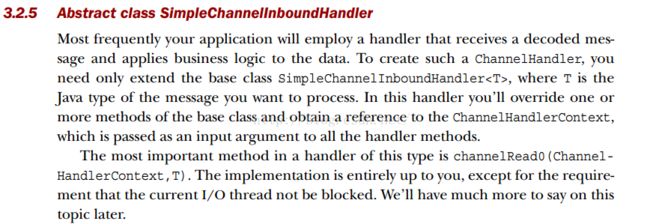一起学Netty(三)之 SimpleChannelInboundHandler
其实Netty的知识点还是很零碎的,比如这个SimpleChannelInboundHandler这个类,在《Netty in Action》该书中的原版的Hello world的demo的客户端就是使用的SimpleChannelInboundHandler来作为处理器的,我本来也是使用这个类作为我处理类的,但是做一个新手,这个类还是让我走了一点弯路,我们可以看到SimpleChannelInboundHandler中有一个channelRead0的方法需要我们实现:
尼玛,我记得当时就是使用的channelRead0这个方法,结果服务器端就是不打印,服务器返回的结果,当时客户端是这样写的
package com.lyncc.netty.component.simplehandler;
import io.netty.buffer.ByteBuf;
import io.netty.channel.ChannelHandlerContext;
import io.netty.channel.SimpleChannelInboundHandler;
public class BaseClientHandler extends SimpleChannelInboundHandler<ByteBuf>{
@Override
protected void channelRead0(ChannelHandlerContext ctx, ByteBuf msg) throws Exception {
System.out.println("Client channelRead0 received:" + msg);
}
// @Override
// public void channelRead(ChannelHandlerContext ctx, Object msg) throws Exception {
// System.out.println("Client channelRead received:" + msg);
//
// }
@Override
public void exceptionCaught(ChannelHandlerContext ctx, Throwable cause) {
cause.printStackTrace();
ctx.close();
}
}
结果channelRead0方法就是不运行执行,让我郁闷了有一会,后来,我打开了SimpleChannelInboundHandler的源码,其实这是我很不想看见的,尼玛,一个hello world就已经开始看源代码了,还让不让人活了啊,结果源码中显示SimpleChannelInboundHandler是继承于ChannelInboundHandlerAdapter,重写了channelRead方法:
@Override
public void channelRead(ChannelHandlerContext ctx, Object msg) throws Exception {
boolean release = true;
try {
if (acceptInboundMessage(msg)) {
@SuppressWarnings("unchecked")
I imsg = (I) msg;
channelRead0(ctx, imsg);
} else {
release = false;
ctx.fireChannelRead(msg);
}
} finally {
if (autoRelease && release) {
ReferenceCountUtil.release(msg);
}
}
}原来我们SimpleChannelInboundHandler后面指定了处理类型,也就是源码中的"I",acceptInboundMessage方法判断msg是不是SimpleChannelInboundHandler中指定的类型,我们这边指定的是ByteBuf,感觉没啥问题啊,但是我们忽略了一个问题,我们客户端中有3个处理器,两个inbound类型的处理器,其中一个就是HelloWorldClientHandler,还有一个就是StringDecoder,此时我内心是崩溃的,尼玛,上一个处理器已经把服务器端的信息转化成String,我还用ByteBuf来接收,能处理才有鬼,修改一下我们的代码就可以了,重新指定一下处理的类型
package com.lyncc.netty.component.simplehandler;
import io.netty.channel.ChannelHandlerContext;
import io.netty.channel.SimpleChannelInboundHandler;
public class BaseClientHandler extends SimpleChannelInboundHandler<String>{
@Override
protected void channelRead0(ChannelHandlerContext ctx, String msg) throws Exception {
System.out.println("Client channelRead0 received:" + msg);
}
// @Override
// public void channelRead(ChannelHandlerContext ctx, Object msg) throws Exception {
// System.out.println("Client channelRead received:" + msg);
//
// }
@Override
public void exceptionCaught(ChannelHandlerContext ctx, Throwable cause) {
cause.printStackTrace();
ctx.close();
}
}
这样就能使channelRead0方法运行了,也怪我眼瞎,书中写的很清楚:
SimpleChannelInboundHandler的channelRead0还有一个好处就是你不用关心释放资源,因为源码中已经帮你释放了,所以如果你保存获取的信息的引用,是无效的~
这个是学习Netty走的一段弯路,在这里跟大家share一下~

